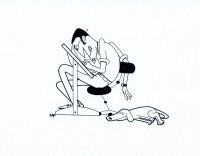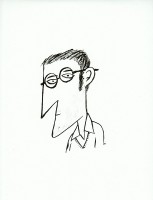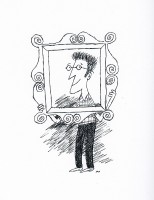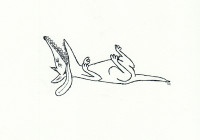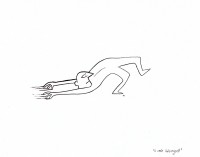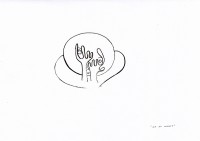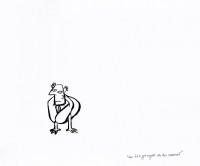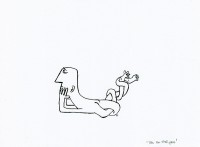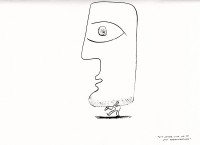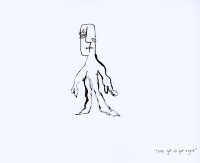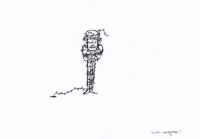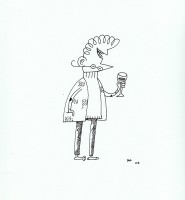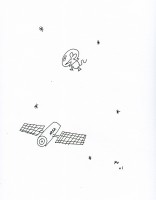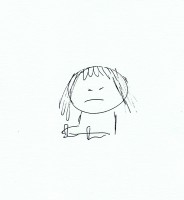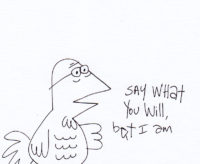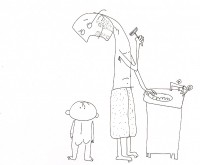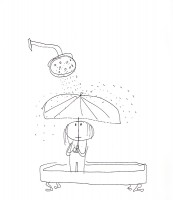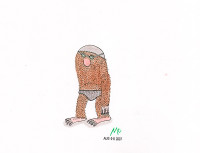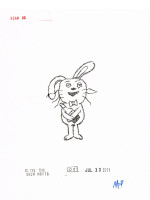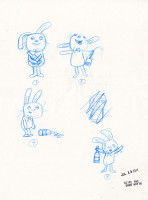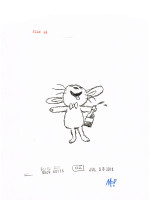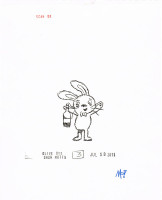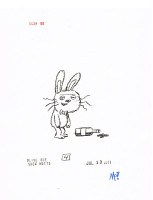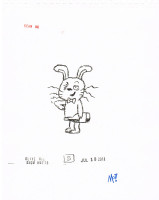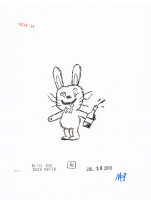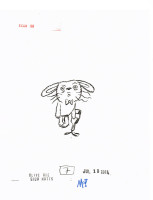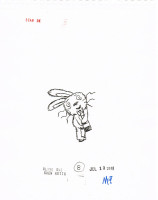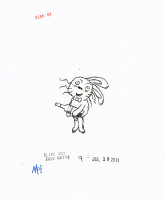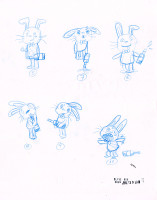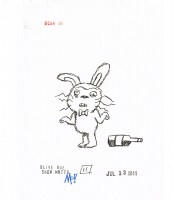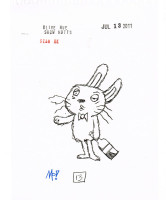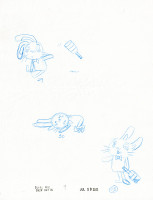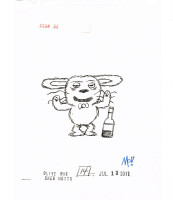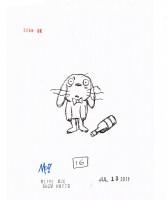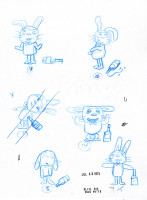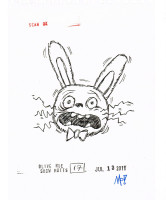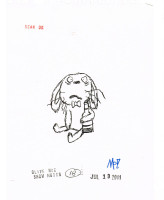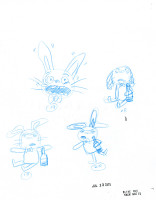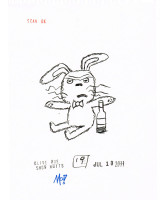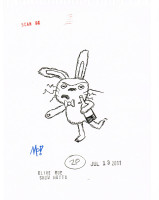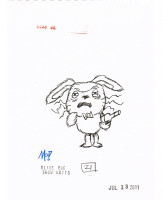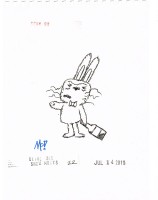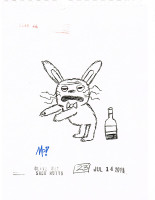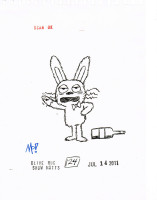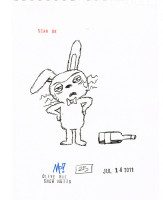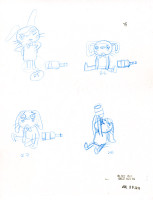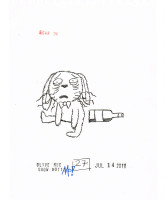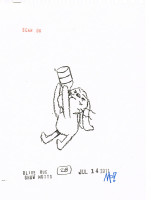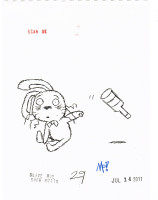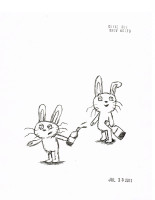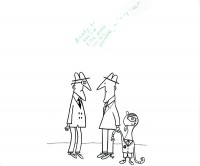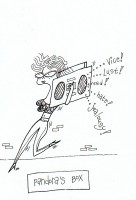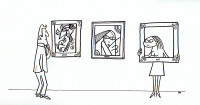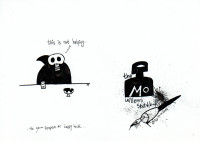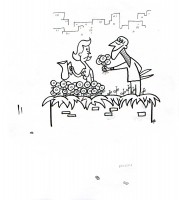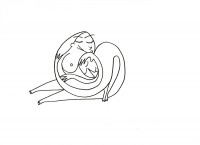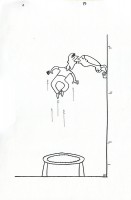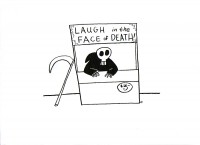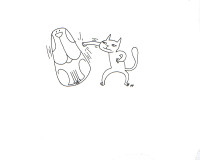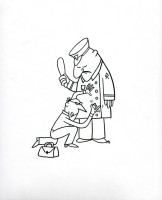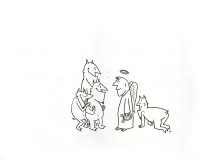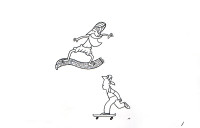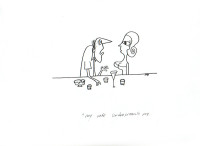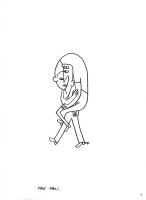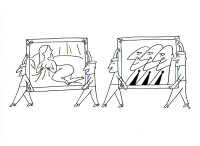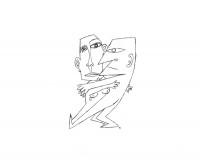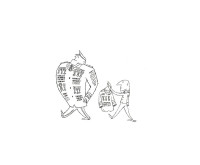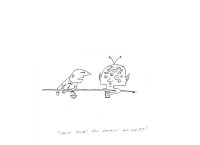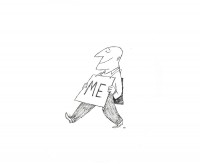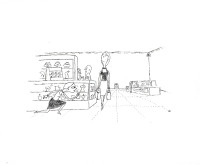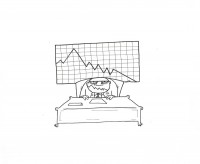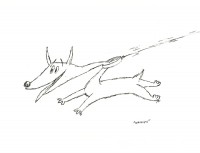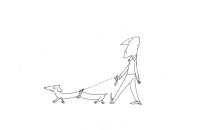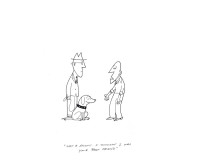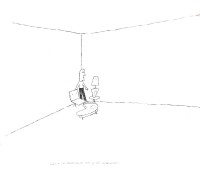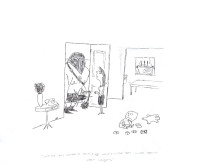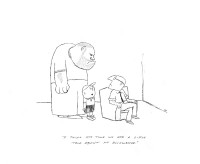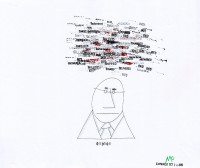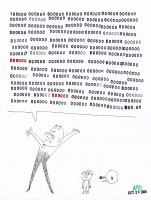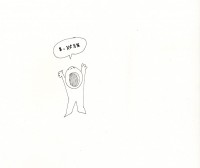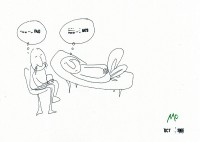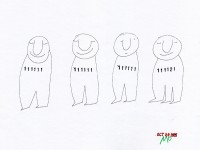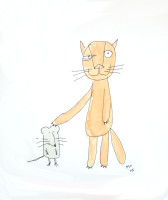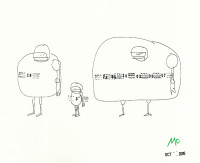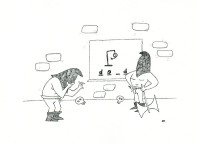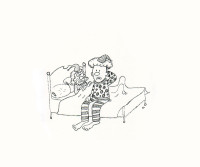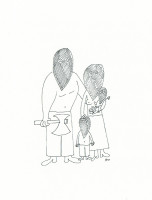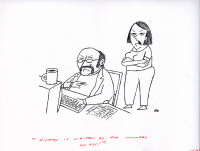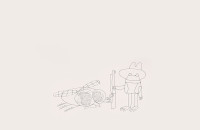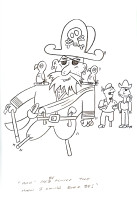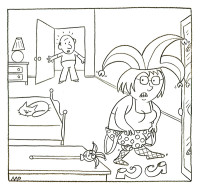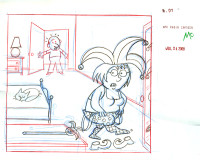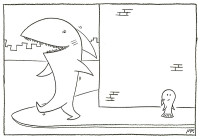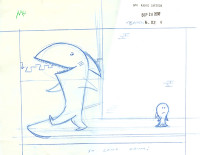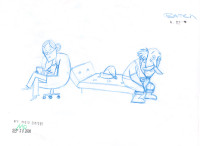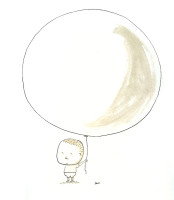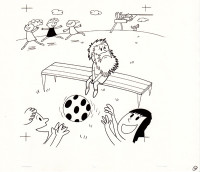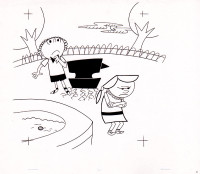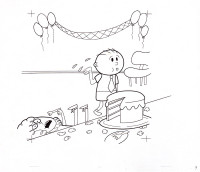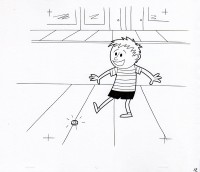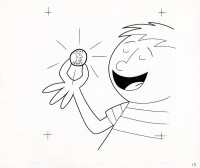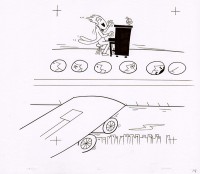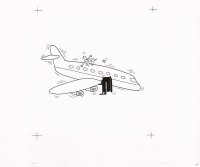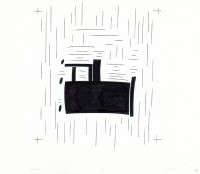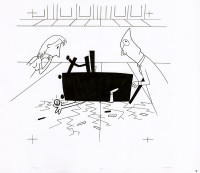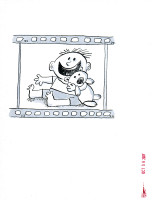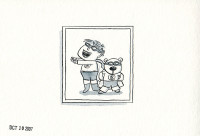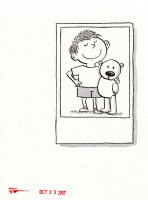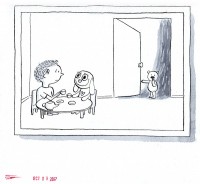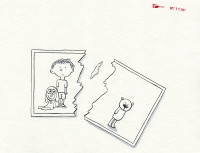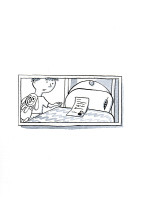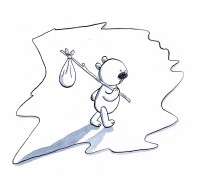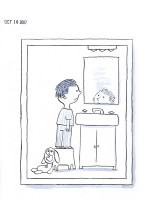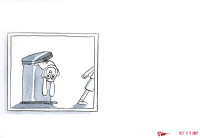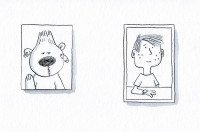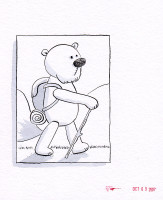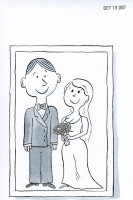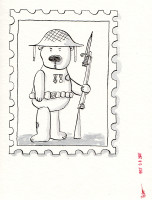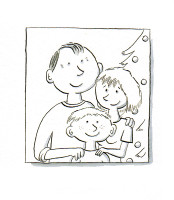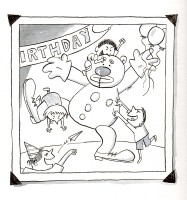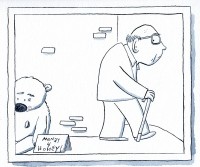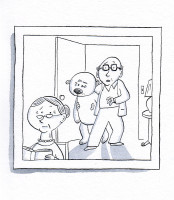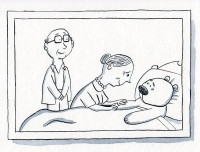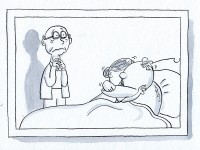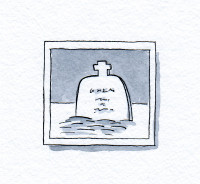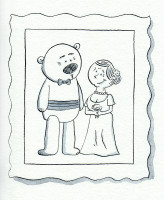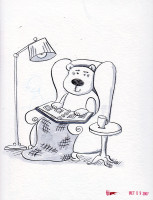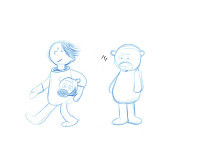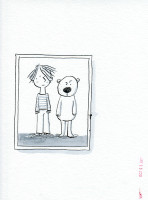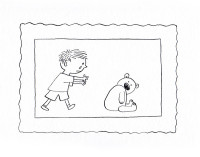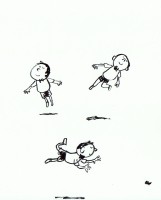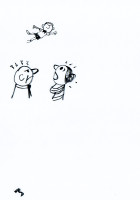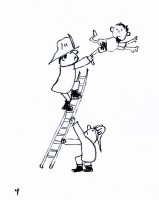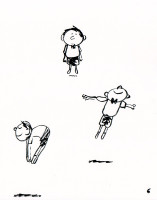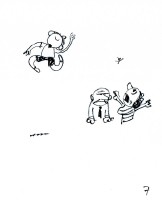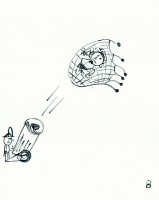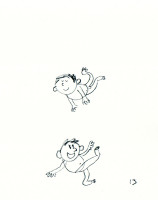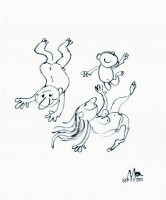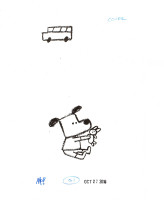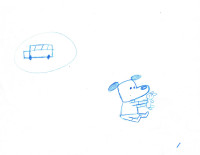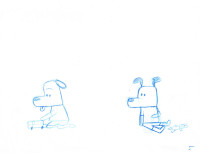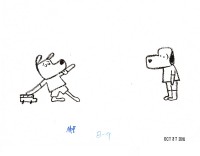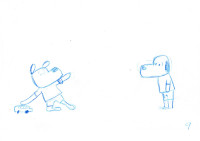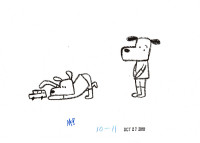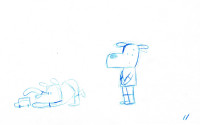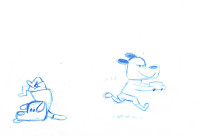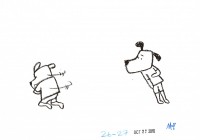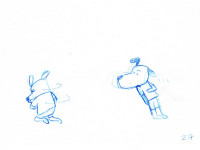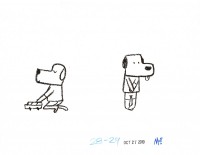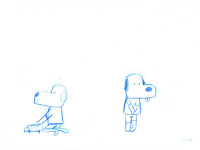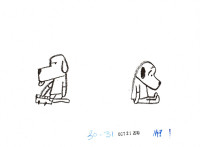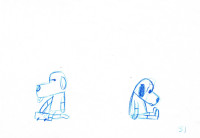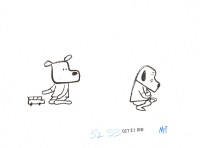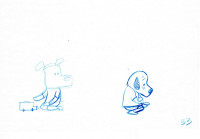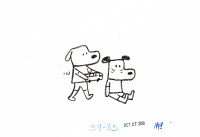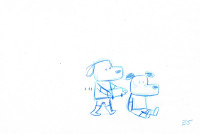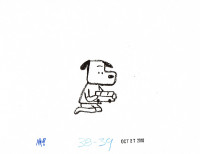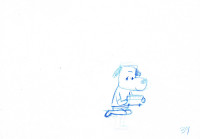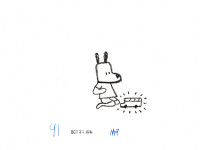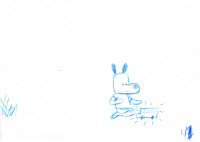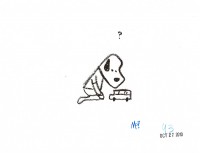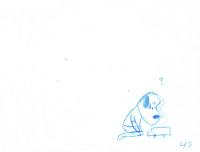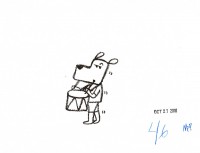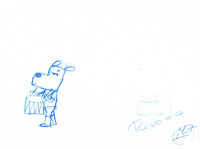Mo Willems: Don’t Pigeonhole Me!
Two Decades of the Mo Willems Sketchbook
The following is a collection of original drawings from Don’t Pigeonhole Me: Two Decades of the Mo Willems Sketchbook. Visit Mo Willems’ sculpture page to see the Magnet Doodles and other sculptures that were also included in the exhibition.
Think of Mo Willems, and his iconic and beloved characters are most likely to spring to mind: The Pigeon, Elephant and Piggie, Trixie (and her Knuffle Bunny), Amanda and many others. But it should come as no surprise to most, that Mo’s inventiveness is as likely to jump off the page. Below is a collection of twenty years of cartoons, doodles, and sketches that show an observant mind continually probing and assessing the quirks and realities of our daily life with humor, sensitivity, and a healthy dose of irreverence.
Don’t Pigeonhole Me Opening Reception
Self-Portraits
“Mo Willems is the most brilliant cartoonist I know, for his height.” — Dave Barry, Pulitzer Prize-winning author and columnist
4.5×5.5 in
5.5×3.25 in
5.75×3.5 in
2×4 in
I’m Fine
“This sketchbook is the result of spending the year rereading and enjoying William Steig’s The Lonely Ones while simultaneously going through a difficult time with my family. I thought I’d try, much like Steig had, to create drawings with quick brushwork that were subconscious.”
7×11 in
8×9.5 in
7×10 in
6×10.25 in
6×9.25 in
11.25×8.75 in
9×8.5 in
8×10 in
Lazy Day Doodles
“These doodles are the product of a particularly busy year. I found myself facing a steep learning curve as I produced my first books [and] was also a new father. Exhausted and frazzled, I turned to doodling for a release. These drawings were made with zero forethought, simply gliding off of the pen onto the page. It was wonderfully relaxing compared to the pressure inherent in all of my other work.”
5.25×3.25 in
7×5 in
2×2 in
2.5×4 in
9×7.5 in
7.25×5.5 in
Monsters in Underpants
“My son and I could often be found on the hallway floor drawing together on big rolls of paper when this volume was made. Monsters are always fun to draw, and underpants are about the funniest thing in the universe, so that year, we started drawing a steady stream of Monsters in Underpants.”
8×10.5 in
9.75×6.5 in
6.5×4.1 in
Olive Hue Show Mutts
“I think we often forget how hard and slow-going learning to read can be when you’re at its cusp, and I wondered what it would be like to go back to that point. The result is this “hard reader,” a drunken diatribe of words that merely sound like what they mean. This story almost requires that you read it aloud, much like children must do when reading their first books independently.”
8×6 in
8.75×8 in
12×9.5 in
8.25×5.25 in
8×5.5 in
8×5 in
8×5.75 in
8×6 in
8.25×5.75 in
9×5 in
8×5 in
7×4.5 in
11.5×10 in
7×5.5 in
6.5×5 in
7×5 in
11×9 in
7×5 in
7×5 in
7×5 in
12.5×9.25 in
7.25×5 in
7×5 in
10.5×10 in
7×5 in
7×5 in
7.25×5 in
6.25×5 in
7×5 in
6.25×4.5 in
12.25×10 in
6.5×5 in
6.5×4.5 in
12.5×10 in
6×4.5 in
6.25×4.5 in
7×5.25 in
6×4.75 in
8.25×6 in
Sketchbook I
“The first sketchbook was put together using gags I’d submitted to real publications, plus a few quickly drawn to fill the volume out. The process of putting the booklet together was surprisingly exciting; it was so much cooler having these jokes stapled together than lying around in my files.”
6×10.25 in
11.5×7 in
4.75×4.25 in
5.25×12 in
7×12.5 in
Sketchbook III
“The Mo Willems Sketchbook … evolved into more of an aesthetic opportunity. I could now experiment with story, characters, drawing styles, and design without any career repercussions. The work became more personal, or darker, or just plain weirder. Every single year, the sketchbook project allowed me the freedom to mess about and even fail in ways I couldn’t, or wouldn’t, otherwise.”
6×6 in
4.5×5.5 in
10×7 in
5×7 in
2.5×4 in
12×4 in
6×4.5 in
5.5×7.5 in
8.5×7 in
5×6 in
8×3 in
4×10.5 in
Sketchbook IV
“In this volume you’ll see the influence of Anatol Kovarsky, an underappreciated cartoonist from the ’50s. I’d found a few volumes of his work, even though most fellow cartoongeek folks I know haven’t heard of him. I love his line and simple, wordless work.”
8.25×3.5 in
14×17 in
5×6 in
7.25×9.5 in
5.5×8 in
7×5 in
6×12 in
8.5×9 in
7.25×7 in
5×10 in
4.5×6 in
8.5×5.5 in
11.5×15.5 in
10×11 in
9×11 in
Stamps, Portraits and Cartoons
“The great New Yorker cartoonist and artist Saul Steinberg has been a hero since I first encountered his work while at NYU… Steinberg’s angular approach and light, improvisational-looking line took my breath away. Inspiration begat emulation, and my drawing style aped his work, particularly in college. One thing that was unique to Steinberg was the way he incorporated stamps and labels into his work, something I’d never done before.”
14×16 in
14×16 in
14×11 in
11×14 in
11×14 in
11×14 in
5×4 in
7.5×11 in
7.5×11.5 in
5.25×7 in
7×4.5 in
9.5×13 in
4×7.25 in
The Devil You Know
“I returned to the gag cartoon format from the first years of making sketchbooks because I discovered that, unlike in the previous years, I already had a bunch of gags that had accumulated in my flat files.”
11.5×9 in
10.75×11 in
9.5×13 in
9.75×12.75 in
11×14 in
6×10.5 in
8×13 in
Wise Things
“I suppose an Edward Gorey influence snuck up in this series of somewhat grim jokes. I’ve always enjoyed Mr. Gorey’s work…I was so tired of rendering jolly roundheaded scamps that my subconscious just wanted to kill them. Which it did in this volume.”
8.25×9 in
8.75×9.25 in
8×9.5 in
10.5×12.5 in
10.5×12.5 in
10.5×12.5 in
10.5×12.5 in
10.5×12.5 in
10.5×12.5 in
A Bear Remembers…
“Stuffed, yet living, teddy bears were … a recurring doodle theme for a while. I thought the idea of a bear aging with its owner was funny, but also a little creepy. And it was the creepiness that kept me from being able to come up with a workable picture book for my bear. Still, I love the weirdness of this story, and I had fun telling a wordless story (a challenge I’d still like to attempt with a picture book). It’s not for kids, but it’s fun.”
12×9 in
8.25×7.25 in
5.75×7 in
7×5.25 in
12×9 in
10×10.75 in
2.75×5.5 in
12×9 in
9.5×7.25 in
5.75×11 in
4.5×8.5 in
7.5×6 in
7.25×6.75 in
11×7 in
9.5×7 in
5.25×5 in
12×9 in
12×9 in
6.5×5.75 in
5.75×8.25 in
12×9 in
2.5×2.5 in
7.5×6.5 in
8.5×8.25 in
4.75×6.5 in
8×7 in
5.5×8.25 in
Float
“Float is the sketchbook that has gotten the most passionate and personal responses from my limited pool of readers. After reading it, friends have bemoaned their childhood, parents have resolved to allow their children greater freedom, and some pals have just cried.”
13.5×11 in
11×4.25 in
13.5×11 in
11×9 in
13.5×11 in
13.5×11 in
7.25×5.5 in
13.5×11 in
The Red Truck
“For The Red Truck, which became my third wordless story sketchbook, I was interested in what could be done with just two colors: black and red. Again, the dog was someone I’d spent the previous months doodling; but this time I planned out the story in a more methodical way than in the previous year.”
9.5×6 in
7.5×10 in
5.25×9.25 in
4.25×10 in
9×12 in
4.5×10.5 in
6×8 in
4.5×10 in
7.5×10 in
4.5×10.5 in
9×12 in
5×10 in
9×12 in
4.5×10 in
8×5 in
3.5×9 in
9×12 in
3.5×10.5 in
5×7 in
4×7 in
5×6 in
4×6 in
5.5×6 in
5×11.75 in
9×12 in
5×5 in
9×12 in
5.5×10 in

